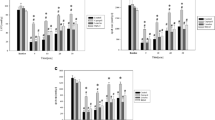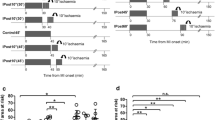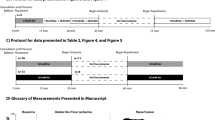Abstract
Halothane has been shown to be a powerful myocardial protectant during normothermic cardioplegic arrest and subsequent reperfusion. In view of its multiple effects on cellular Ca2+ movements and the role of this ion in ischemia-reperfusion injury, the questions of whether halothane is capable of maximally protecting the heart or whether combination therapy of halothane with other Ca2+ blocking agents may be more effective arose. Therefore, the effects of combination therapy with halothane and a calcium antagonist (nifedipine), or a Na+/H+ inhibitor (HOE 694), or a Na+/Ca2+ inhibitor (quinacrine) on postcardioplegic functional recovery were evaluated. The isolated perfused rat heart subjected to 45 minutes normothermic cardiac arrest was used as an experimental model. Dose–response curves were performed for each drug. Using the optimal dosage for each drug, the following results were obtained: (1) Nifedipine (10−7 M; administered retrogradely 10 minutes before and after cardioplegia) and halothane (1.5% administered during cardioplegia), when administered separately, improved functional recovery. Combination therapy did not further improve protection. (2) HOE 694 (10−7 M) or quinacrine (10−9 M) improved postcardioplegic functional recovery when added for 2 minutes at the onset of reperfusion. Simultaneous administration of HOE 694 and 1.5% halothane was the only combination that yielded additive protection. (3) Quinacrine, a phospholipase and Na+/Ca2+ exchanger inhibitor, appeared to be the most powerful drug used. In summary, the results obained indicate that interventions aimed at preventing intracellular Ca2+ overload improve recovery after cardioplegic arrest. The beneficial effects of halothane could be further improved by HOE 694.
Similar content being viewed by others
References
Coetzee A, Brits W, Genade S, Lochner A. Halothane does have protective properties in the isolated ischemic rat heart. Anesth Anal 1991;73:711-719.
Drenger B, Ginosar Y, Gozal Y. Effect of halothane on sarcolemmal calcium channels during myocardial ischemia and reperfusion. Adv Pharmacol 1994;31:89-97.
Davis RF, De Boer LWV, Rude RE, Lowenstein E, Maroko PR. The effect of halothane anesthesia on myocardial necrosis, hemodynamic performance and regional myocardial blood flow in dogs following coronary artery occlusion. Anesthesiology 1983;59:402-411.
Cope DK, Impastato WK, Cohen MV, Downey JM. Volatile anesthetics protect the ischemic rabbit myocardium from infarction. Anesthesiology 1997;86:699-709.
Lochner A, Harper I S, Salie R, Genade S, Coetzee AR. Halothane protects the isolated rat myocardium against Ca2+ overload and structural damage during ischaemia and reperfusion. Anesth Analg 1994;79:226-233.
Hoka S, Bosjnak ZJ, Kampine JP. Halothane inhibits calcium accumulation following myocardial ischaemia and calcium paradox in guinea pig hearts. Anesthesiology 1987;67: 197-202.
Mongo KG, Vassort G. Inhibition by alcohols, halothane and chloroform of the Ca2+ current in single frog ventricular cells. J Mol Cell Cardiol 1990;22:939-953.
Schmidt U, Schwinger RH, Bohm S, et al. Evidence for an interaction of halothane with the L-type Ca2+ channel in human myocardium. Anesthesiology 1993;79:332-339.
Lee DL, Zhang J, Blanck TJ. The effects of halothane on voltage-dependent calcium channels in isolated Langendorff-perfused rat heart. Anesthesiology 1994;81:1212-1219.
Haworth RA, Goknur AB. Inhibition of sodium/calcium exchange and calcium channels of heart cells by volatile anesthetics. Anesthesiology 1995;82:1255-1265.
Baum VC, Wetzel GT. Sodium-calcium exchange in neonatal myocardium: Reversible inhibition by halothane. Anesth Analg 1994;78:1105-1109.
Drenger B, Ginosar Y, Chandra M, Reches A, Gozal Y. Halothane modifies ischemia-associated injury to the voltagesensitive calcium channels in canine heart sarcolemma. Anesthesiology 1994;81:221-228.
Sivarajan M, Su JY, Hofer BO. Effects of halothane on calcium (2+)-activated tension of the contractile proteins and calcium (2+)-uptake and release by the sarcoplasmic reticulum in skinned human fibers. Anesth Analg 1995;81:52-56.
Frazer M J, Lynch C. Halothane and isoflurane effects on Ca2+ fluxes of isolated myocardial sarcoplasmic reticulum. Anesthesiology 1992;77:316-323.
Evers AS, Hossain MD. Volatile anesthetic effects on inositol trisphosphate-gated intracellular calcium stores in GH3 cells. Adv Pharmacol 1994;31:343-350.
Connelly TJ, Coronado R. Activation of the Ca2+ release channel of cardiac sarcoplasmic reticulum by volatile anesthetics. Anesthesiology 1994;81:459-469.
Wheeler DM, Katz A, Rice RT, Hansford RG. Volatile anesthetics effects on sarcoplasmic reticulum Ca2+ content and sarcolemmal Ca2+ flux in isolated rate cardiac cell suspensions. Anesthesiology 1994;80:372-382.
Glantz L, Ginosar Y, Chevion M, et al. Halothane prevents postischemic production of hydroxyl radicals in the canine heart. Anesthesiology 1997;86:440-447.
Poole-Wilson PA, Harding DP, Bourdillon PDV, Tomes MA. Calcium out of control. J Mol Cell Cardiol 1984;16:175-187.
Murphy JG, Smith TW, Marsh JD. Mechanisms of reoxygenation-induced calcium overload in cultured chick embryo heart cell. Am J Physiol 1988;254:H1133-1141.
Kloner RA, Przyklenk K. Clinical evidence that nisoldipine attenuates stunning in patients post infarction. Cardiovasc Drugs Ther 1997;11:17-18.
Ehring T, Heusch G. Dihydropyridine calcium antagonists: Beneficial or adverse effects in the setting of myocardial ischaemia reperfusion. Cardiology 1997;88(Suppl. 1):3-14.
Bugge E, Munch-Ellingsen J, Ytrehus K. Reduced infarct size in the rabbit heart in vivo by ethylisopropyl-amiloride. A role for Na+/H+ exchange. Basic Res Cardiol 1996;91: 203-209.
Klein HH, Pich S, Bohle RM, Wollenweber J, Nebendahl K. Myocardial protection by Na+-H+ exchange inhibition in ischemic, reperfused porcine hearts. Circulation 1995;92: 912-917.
Yasutake M, Ibuki C, Hearse DJ, Avkiran M. Na+/H+ exchange and reperfusion arrhythmias: Protection by intracoronary infusion of a novel inhibitor. Am J Physiol 1994;267:H2430-H2440.
Du Toit EF, Opie LH. Modulation of severity of reperfusion stunning in the isolated rat heart by agents altering Ca2+ flux at onset of reperfusion. Circ Res 1992;70:960-967.
Armstrong SC, Ganote CE. Effects of phospholipase inhibitor mepacrine on injury in ischemic and metabolically inhibited adult isolated myocytes. Am J Pathol 1991;138:545-555.
Chiariello M, Ambrosio G, Cappelli-Bigazzi M, Nevola E, Perrone-Filardi P, Marone G, Condorelli M. Inhibition of ischemia-induced phospholipase activation by quinacrine protects jeopardized myocardium in rats with coronary artery occlusion. J Pharmacol Exp Ther 1987;241:560-568.
Miller LS, Barret JN, Cameron JS, Bassett AL. Differential effects of calcium antagonists on viability of adult rat ventricular myocytes. J Mol Cell Cardiol 1985;17:1129-1137.
Hattingh PW, Coetzee AR, Lochner A. Effect of beta-blockade and calcium antagonists on the response of the isolated working rat heart to adrenergic stimulants after cardioplegic arrest. Cardiovasc Drugs Ther 1993;7:851-861.
Tanquay M, Jasmin G, Blaise G, Dumont L. Resistance of the failing dystrophic hamster heart to the cardioprotective effects of diltiazem and clentiazem: Evidence of coronary vascular dysfunctions. Can J Physiol Pharmacol 1995;73:1108- 1117.
Tani M, Neely JR. Role of intracellular Na+ in Ca2+ overload and depressed recovery of ventricular function of reperfused ischemic rat hearts. Circ Res 1989;65:1045-1056.
Khandoudi N, Bernard M, Cozonne P, Feuvray D. Intracellular pH and the role of the Na+/H+ exchange during ischaemia and reperfusion of normal and diabetic rats. Cardiovasc Res 1990;24:873-878.
Klein HH, Pich S, Bohle RM, Wollenweber J, Nebendahl K. Myocardial protection by Na+/H+ exchange inhibition in ischemic, reperfused porcine hearts. Circulation 1995;92: 912-917.
Hendrikx M, Mubagwa K, Verdonck F, et al. New Na2+/H2+ exchange inhibitor HOE 694 improves postischemic function and high energy phosphate resynthesis and reduce Ca2+ overload in isolated perfused rabbit heart. Circulation 1994;89:2787-2798.
Kaczorowski G, Slaughter RS, King VF, Garcia ML. Inhibitors of sodium-calcium exchange: Identification and development of probes of transport activity. Biochim Biophys Acta 1989;988:287-302.
Van Bilsen M, Van der Vusse GJ, Willemsen PH, Coumans WA, Roemen TH, Reneman RS. Effects of nicotinic acid and mepacrine on fatty acid accumulation and myocardial damage during ischemia and reperfusion. J Mol Cell CardioI 1990;22:155-163.
Karmazyn M, Watson JE, Moffat MP. Mechanism of cardiac depression induced by phorbol myristate acetate in working rat hearts. Br J Pharmacol 1990;100:826-830.
De la Pena, Reeves JP. Inhibition and activation of Na+-Ca2+ exchange activity with quinacrine. Am J Physiol 1987;252: C24-C29.
Stokke M, Hagelin EM, Poulsson C, Patel R, Haile Y, Brors O. Inhibition by amiloride and quinacrine of specific [3H] nitrendipine binding to rat cardiac membranes. J Pharm Expt Ther 1992;260:1366-1372.
Author information
Authors and Affiliations
Rights and permissions
About this article
Cite this article
Lochner, A., Genade, S., Tromp, E. et al. Postcardioplegic Myocardial Recovery: Effects of Halothane, Nifedipine, HOE 694, and Quinacrine. Cardiovasc Drugs Ther 12, 267–277 (1998). https://doi.org/10.1023/A:1007765732582
Issue Date:
DOI: https://doi.org/10.1023/A:1007765732582




